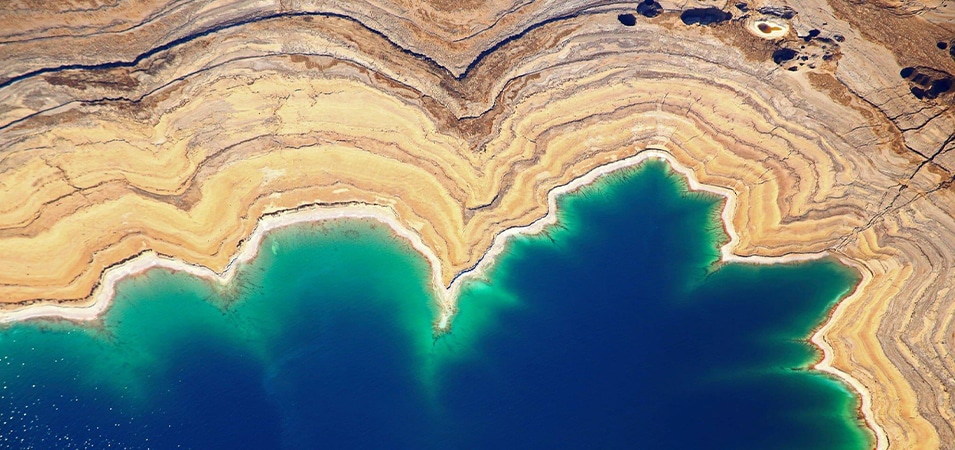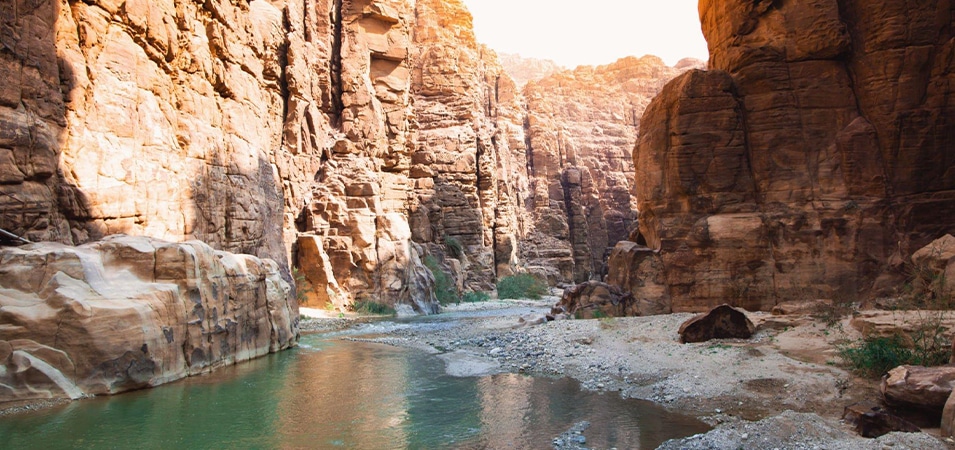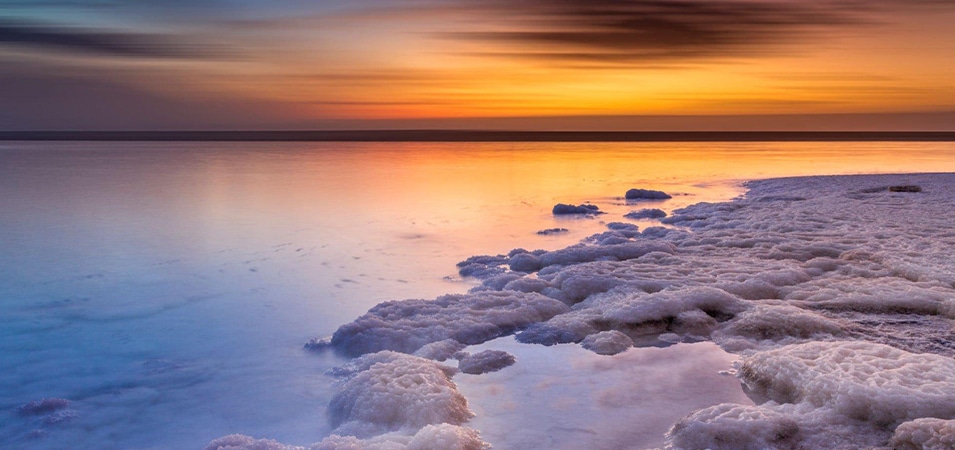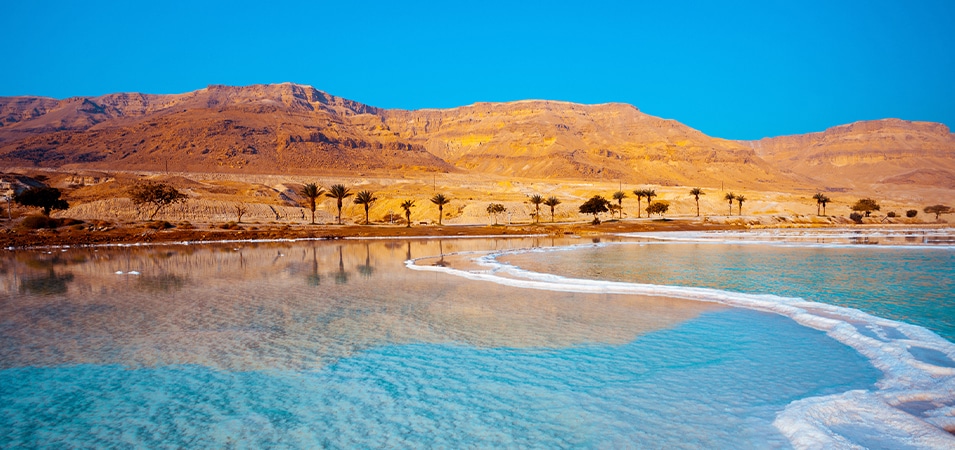The Enchanting Dead Sea, between Jordan and Palestine, is a geographical wonder with immense significance.One of Earth’s saltiest lakes, it is famous for its high salt concentration. The Dead Sea’s unique features and attractions make it an absolute must-visit destination for travelers from across the globe.
With a surface area of approximately 605 square kilometers (234 square miles), the Dead Sea’s saline composition creates a natural buoyancy that allows swimmers to float on its surface effortlessly. This extraordinary phenomenon provides a truly unparalleled and surreal experience, drawing visitors who seek the sensation of weightlessness amidst the soothing waters.
Besides its buoyancy, the Dead Sea is known for its minerals. Salts and minerals including magnesium, calcium, and potassium are abundant there. These minerals treat skin and health conditions. Many visitors flock to the Dead Sea to immerse themselves in the healing qualities of its mud and minerals, indulging in spa treatments and mud baths to rejuvenate their bodies and minds.
Notwithstanding its natural beauty, the Dead Sea area is rich in history and culture.Archaeological discoveries in the area have unveiled ancient sites and artifacts that offer a glimpse into the past. A UNESCO World Heritage Site, Masada, and Qumran Caves contained the Dead Sea Scrolls. These remnants of ancient civilizations add to the region’s allure, attracting history enthusiasts and curious explorers.
Don’t Miss checking out our Jordan Travel Packages.
The History of the Sea

The Dead Sea, located in the Jordan Rift Valley between Jordan and Israel, has a long and fascinating history.
- The Dead Sea region has been inhabited for millennia. Biblically, it was the “Salt Sea” or “Sea of the Arabah.” The area around the Dead Sea was part of the biblical kingdoms of Sodom, Gomorrah, and Moab.
- The Dead Sea is renowned for its high salt concentration, making it one of Earth’s saltiest bodies of water. Its mineral-rich waters, containing high magnesium, potassium, and calcium levels, have attracted visitors seeking their therapeutic benefits for centuries.
- The Latin name for the Dead Sea was “Mare Mortuum” during the Roman Empire. Its unusual features led the Romans to build cities like Masada on a mountain overlooking the sea.
- The Dead Sea holds significant religious importance. It is mentioned in the Hebrew Bible in relation to Lot, Abraham’s nephew, and Sodom and Gomorrah’s destruction. They also think John the Baptist baptized Jesus at sea.
Summary of its historical significance and key events
- The first detailed written accounts of the Dead Sea come from ancient historians such as Herodotus and Pliny the Elder. They described its unusual properties and that no living organisms could survive in hypersaline waters.
- In the 19th century, Western explorers and scientists began to study the Dead Sea more extensively. They discovered its unique geological and mineralogical characteristics and the therapeutic properties of its mud and minerals.
- In the early 20th century, the extraction of minerals from the Dead Sea began on a larger scale. Potash, bromine, and other minerals found in the sea and its surroundings became valuable resources for industrial use.
- Due to its strategic location, the Dead Sea area has been a site of political tensions and conflicts. During the 1948 Arab-Israeli war, the sea’s northern and western shores came under Jordanian control, while Israel controlled the southern portion.
- The Dead Sea has faced environmental challenges in recent decades. Its water levels have steadily declined due to diversifying water sources and natural evaporation. This has resulted in the formation of sinkholes and shrinking their surface area.
Top Attractions and Activities To Do In the Sea

The Dead Sea, between Jordan and Israel, is a salty marvel with medicinal properties.
- Due to the high salt concentration in the water, it is nearly impossible to sink into the Dead Sea. Visitors can effortlessly float on the surface, an experience that is both relaxing and fun.
- The Dead Sea mud is rich in minerals and is believed to have numerous health benefits for the skin. Many visitors indulge in mud baths or apply them directly on their bodies for a natural spa treatment.
- Several public beaches line the The Enchanting Dead Sea shores, offering relaxation facilities, sunbathing, and enjoying the unique scenery. Some famous beaches include Ein Bokek Beach in Israel and Amman Beach in Jordan.
- The Dead Sea’s shores are dotted with beautiful salt formations created by the evaporation of water. Exploring these crystallized salt formations and taking stunning photographs is a popular activity.
Top attractions and activities you can experience at the Dead Sea
- The Dead Sea region is home to numerous luxurious resorts and spas that offer a range of wellness treatments. From mineral-rich baths and massages to skin treatments, these spas provide a rejuvenating experience.
- Hiking and Natural Reserves: Desert canyons and nature reserves encircle the Dead Sea. Ein Gedi and Mujib Natural Reserves are famous trekking and exploration spots.
- Many notable events occurred at the biblical Dead Sea. The Sea Scrolls were unearthed in Qumran and Masada, an ancient stronghold.
- The Sea offers ATV rides, camel treks, and off-road tours in the surrounding desert for those seeking adventure. These activities provide an exhilarating way to experience the region’s unique terrain.
- The Dead Sea’s stunning sunsets are a sight to behold. Finding a vantage point to witness the golden hues reflecting off the water and the surrounding landscapes is a memorable experience.
- The region is known for its range of skincare products made from the minerals and salts of the Dead Sea. Visitors can explore local shops and markets to purchase these products, known for their beneficial effects on the skin.
Historical Sites near The Dead Sea

The Dead Sea region is a treasure trove of historical sites, offering visitors a glimpse into the past and a deeper understanding of the civilizations that once thrived in the area. Here are some notable historical sites near the Dead Sea:
Masada: Perched atop a towering cliff, Masada is an iconic fortress that tells the story of Jewish resistance against the Romans in ancient times. It is a UNESCO World Heritage site and offers breathtaking views of the Dead Sea and the surrounding desert.
Qumran Caves: Located near the northwestern shore of the Dead Sea, the Qumran Caves are famous for discovering the Enchanting Dead Sea Scrolls. These ancient manuscripts provide invaluable insights into religious and cultural practices during the Second Temple period.
Jericho: Known as one of the oldest inhabited cities in the world, Jericho is a short distance from the Dead Sea. Tel Jericho features historic city walls and buildings.
Bethany Beyond the Jordan: This biblical site is believed to be where Jesus was baptized by John the Baptist. Pilgrims can explore the archaeological remains and visit the Jordan River, which holds immense religious significance.
Madaba: Madaba’s Byzantine and Umayyad mosaics are famous farther from the Dead Sea. The city is home to the famous Madaba Map, a mosaic map of the Holy Land dating back to the 6th century.
Best Time to Visit the Dead Sea

The best time to visit The Enchanting Dead Sea is during the spring (March to May) and autumn (September to November) seasons. The weather is mild and pleasant during these periods, with relaxing outdoor activities and exploration temperatures. Summers can be scorching hot, with temperatures reaching extreme highs, while winters are relatively mild but can be chilly. It’s important to note that the Dead Sea region experiences a desert climate, so avoiding the peak of summer and winter seasons is advisable. Spring and autumn offer a balance of pleasant temperatures, making it an ideal time to fully enjoy the natural wonders and attractions of the Sea.
Don’t Miss to Check out our Related Article :
